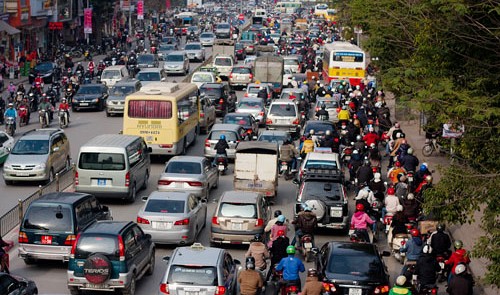Hanoi population management faces challenges

Mechanical population increases by 50,000 people per year
After Hanoi expanded its administrative boundaries, merging Hanoi and Ha Tay province in 2008, the capital city’s population has reached 7.1 million. In the four years from 2008 to 2011, the population increased by 430,000 people per year. The mechanical population (not natural, caused by immigration) on average grew by 50,000 per year, with working age people in the majority.
Besides the positive effects like improving young laborers and gathering high-quality human resources, the growth of the mechanical population has also put pressure on socio-economic and urban development.
Specifically, it has caused an overload at local hospitals and schools, as well as problems for population control, and has decreased the quality of family planning and reproductive health care services. Hanoi’s average population density is estimated at 8 times higher than the country as a whole. Moreover, the population distribution in the capital city is also uneven, and there remains a big difference between rural and urban areas. In addition, the mechanical population increase has also had a negative impact on urban traffic, the environment and citizens’ life quality, because migrants usually live in areas with low living standards, such as along rivers and near markets.
Low living standards
Low living standards and uneven living standards between urban and rural areas also remain issues for Hanoi population officials to deal with.
More than 30 ethnic minority groups with different educational levels and living standards live in many regions of Hanoi. There are differences in awareness of family planning and reproductive health care services, as well as the benefits of those services among the groups and regions. In fact, in the suburban districts, the gender disparity ratio at birth is often very high.
For those reasons, local authorities are concerned with increasing population quality and erasing population quality differences among regions.
In recent years, Hanoi population authorities have strengthened the promotion of health care services for disadvantages areas and ethnic minority groups. However, the lack of population officials in rural districts is still an obstacle.
For its part, the Hanoi Population and Family Planning Department has launched many community services to increase quality of life, such as elderly health care services, premarital counseling, and reproductive health care.
Also, the Department is launching a VND100 billion (US$4.75 million) project in Hanoi’s 29 districts during the 2013-2015 period to diagnose and discover birth defects before and right after babies are born. According to Department statistics, babies born with defects account around 1.5% - 2% of local infants. Targets of the project include: 98% pregnant women are consulted before giving birth, 95% of pregnant women have reproductive health checks before giving birth, and 90% of infants have a health check after being born.
According to Ta Quang Huy, head of the Department, to reach the targets, the Population Sector has to expand the network of population officials and improve the specialization of officials and put more investment into infrastructure for population and Family Planning centers in the city.
What the stars mean:
★ Poor ★ ★ Promising ★★★ Good ★★★★ Very good ★★★★★ Exceptional
Latest News
More News
- Protect what’s next: towards a future free from meningococcal group B disease (December 05, 2025 | 18:00)
- New ILO report offers policy recommendations for disability inclusion (December 04, 2025 | 15:18)
- Maternal job loss may affect children’s mental health, research shows (December 03, 2025 | 19:11)
- Women lead Vietnam’s shift to climate-resilient agriculture (December 03, 2025 | 19:10)
- Experts highlight unpaid care work as key barrier to gender equality (December 03, 2025 | 15:15)
- Opportunities and inequalities for women workers in Vietnam's garment industry (December 03, 2025 | 09:00)
- Vietjet flights carry love to devastated central region (November 28, 2025 | 11:35)
- New initiative to boost the fight against domestic violence (November 26, 2025 | 10:00)
- South Korea funds IOM relief for Vietnam’s typhoon-affected communities (November 24, 2025 | 15:33)
- AI and human-centred values set to shape the future of HR in Vietnam (November 21, 2025 | 18:04)

















 Mobile Version
Mobile Version